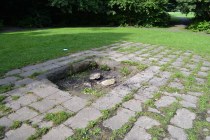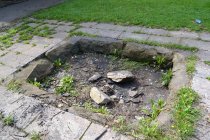The sad plight of St. Bede’s Well Jarrow
Surrounded by worn paving slabs in a small amphitheatre reached by steps and surrounded by trees are the sad remains of Bede’s Well. Dry, with broken stone work it is a rather unprepossessing site. Yet it was once a famed site associated with the county’s famed son. The earliest reference to this site is Floyer in 1702 which notes that
“Nothing is more Common in this Country… for the preventing or curing of Rickets, than to send Children of a Year old and upwards, to St Bede’s… Well”
Brand (1789) says that:
“about a mile to the west of Jarrow there is a well, still called Bede’s Well, to which, as late as the year 1740, it was a prevailing custom to bring children troubled with any disease or infirmity; a crooked pin was put in, and the well laved dry between each dipping. My informant has seen twenty children brought together on a Sunday, to be dipped in this well; at which also, on Midsummer-eve, there was a great resort of neighbouring people, with bonfires, musick, &c”.
A report in the Sunderland Times quoted by Hope (1893) notes that:
“Still, when the well is occasionally cleared out, a number of crooked pins (a few years ago a pint) are always found among the mud. These have been thrown into the sacred fount for some purpose or other, either in the general way as charms for luck, or to promote and secure true love, or for the benefit of sick babies… In days when the ague was common in this country, the usual offering… was a bit of rag tied to the branch of an overhanging tree or bush”
A visitor reported an early morning journey to the well, where ‘he seated himself on a rail to enjoy the singing of the birds. Before long an Irishman came up, who had been walking very fast, and was panting for breath. He took a bottle out of his pocket, stooped down and filled it from the well, put it to his mouth, and took a copious draught. “A fine morning, sir”, said our friend. “Sure and it is”, replied the man, “and what a holy man St Bede must have been ! You see, when I left Jarrow, I was as blind as a bat with the headache, but as soon as I had taken a drink just now, I was as well as ever I was in my life”. So he filled his bottle once more with the precious liquid, and walked away
Sadly the well was a victim of progress from the early days of the industrialisation of the region. In the Victorian period, what was more a rural idyll became surrounded by blast furnaces and the site was nearly buried in slag.
Restored
Fortunately, local people in the early 1900s became concerned with its plight and money was raised via an appeal in the Jarrow Guardian. Although some money was forthcoming, nothing appears to have happened until 1932 when it was enclosed in a railed enclosure with its name carved into the stone work either side of a gate way.
Why St. Bede?
Jarrow has long claimed an association with the saint, but it is unclear whether or not this can be proved. The legend locally says that when living at St. Paul’s Monastery he would send the monks out to collect water from this well. However, it has been questioned why? Especially as the well is some distance away, a well was found enclosed in the site and in fact the river nearby would have been clean enough to drink.
Bede or Baed?
It is possible that the site derives its name from the Anglo-Saxon word baed meaning bathing place and as such perhaps the site was dug to provide a healing bath. Perhaps we shall never know, but what is clear is that the site is slowly disappearing into obscurity.
Posted on January 19, 2014, in Durham, Folklore, Pilgrimage, Restoration, Saints and tagged Catholic pilgrims, County Durham, Holy well blog, jarrow, Sunderland, venerable bede. Bookmark the permalink. Leave a comment.



Leave a comment
Comments 0